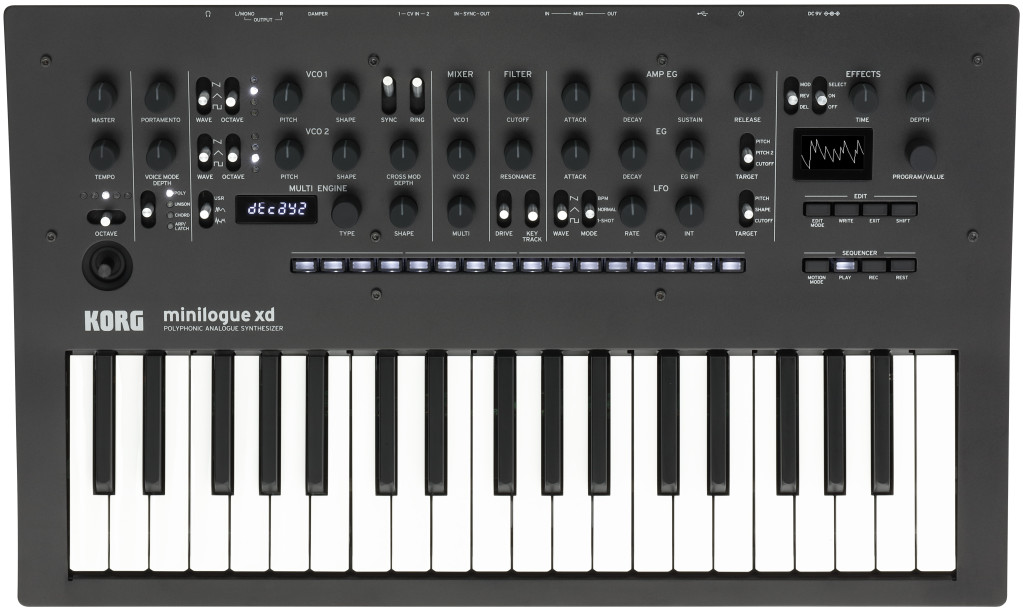KORG are introducing the Minilogue xd. It’s not just a Minilogue with some extras: it’s a new polysynth with the best bits of all the KORG analog range, including the prologue flagship, in a compact package.
It’s like the hatchback of synths – the compact, mid-range priced synth that might just wind up being everyone’s favorite. It’s poised to be the Golf GTI of electronic instruments.
It’s in the compact monologue form factor, with a US$$619.99 price. And it’s coming soon (this winter, so… at least “before spring”). (Updated: KORG even lowered the price at the last minute.)
To be honest, I loved the original of this series, the minilogue. But then with each new iteration, KORG added something new that made me want a combination of all the other synths.
And now, sure enough, what do we get? A combination of all the other synths.
From the minilogue: the elegant 4-voice polyphonic voice structure and voice modes that made the original so terrific. And you get the portable 3-octave for factor of the original, as well.
From the monologue: the 16-step sequencer and microtuning features. (Thanks, Aphex Twin!)
From the prologue: the MULTIdigital oscillator, plus new effects – including an effects architecture that lets you apply multiple effects at once. And biggest of all:
It extends the open platform of the prologue: Now both the prologue and minilogue xd support KORG’s new open SDK and programming environment, meaning you can add new sonic capabilities from KORG and third-party developers. It’s basically the equivalent of having a plug-in architecture for your hardware keyboard – and indeed even desktop software developers are getting involved. (The difference being, of course, no computer required and more stable operation. Ahem.)
Overall the combination of features and form factor will mean for many people this is the perfect KORG synth.
The new architecture: 2VCO + MULTI ENGINE, 1VCF, 2EG, 1VCA, and 1LFO.
That’s three oscillators plus filter drive – and new effects, features, and the ability to download even more from the Internet. So the xd easily bests the mini- and monologue before it.
More oscillator goodness. The multi-engine is something we first saw on the prologue flagship. It gives you a noise generator, a rich and edgy “variable phase modulation” and FM oscillator, and then the ability to load your own user oscillators. There’s a morphing wavetable to get you started, but you can go download more online.
More effects. The effects side is deep, too – stack modulation effects, reverb, and delay together, with chorus, ensemble, tape delay, and various reverb flavors pre-loaded. Plus as with the prologue, you can load your own custom programs – including third-party developer extensions.
Tons of voice mode options. Part of the original appeal of the minilogue was its various voice modes, offering lots of creative options.
Stereo output, 3 effects at once. You get stereo output, too… and you can layer as many as three effects simultaneously, which bests even the top-of-range prologue (which can do two at once, albeit with of course more voices).
At first, it looks like you have only four modes out of the eight from the original minilogue – and yes, these four are there by default with dedicated buttons:
– POLY: The minilogue xd operates as a four-voice polyphonic synth.
– UNISON: The unit operates as a monophonic synth, with the four voices working in unison.
– CHORD: Chords are produced using one to four voices.
– ARP / LATCH: (ARP) Provides an arpeggiator with up to four voices that can also be used while the sequencer is running / (LATCH) Switches latch on or off.
But there’s more on offer once you tweak the ‘voice mode depth’ knob – including giving you a mono mode of sorts:
– POLY: Turning the knob toward the right switches to DUO mode and deepens the detune.
– UNISON: Turning the knob toward the right deepens the detune.
– CHORD: Selects mono or chord type.
– ARP / LATCH: (ARP) Selects the arpeggiator type.
The mono mode isn’t quite like what you got on the minilogue – chord mode when you have depth set to mono means essentially just one note, with legato and portamento. But the original minilogue and prologue still have an advantage here – 1- and 2-octave layering in mono mode.
Voice mode depth was on the original minilogue, too – you do still miss out on some of those modes (like sidechain), but the important ones are here. The poly/duo trick here is inherited from the prologue. The first minilogue therefore retains some of its estoeric worth. But I think what’s worth noting here, though, is the architecture is deeper in every other way – and the new prologue oscillators have a richer timbral range – even before you get to all those new effects, microtuning, and software expandability.
Plus a new joystick. One thing we perhaps won’t miss from the original minilogue and monologue is the weird paddle-style pitch/mod fader. There’s a new compact joystick to handle pitch and modulation as X/Y; we’ll have to see how that feels, but it at least saves space.
And CV. Also new: two CV inputs for those wanting to interface with other analog gear.
Hilariously that “XD” of course also signifies “lol,” which may be how you feel if you just sold off a monologue or minilogue and now can buy up a combination of the two. (As with Windows XP, KORG are using the lowercase xd to de-emphasize that a little…)
Sing along:
Obligatory! Demo! Video!
The original minilogue will continue to be available from KORG, meaning it could make a great value buy even new (and I expect we’ll see more on the used market). But the xd looks seriously hot. Check the full specs, online now:
https://www.korg.com/us/products/synthesizers/minilogue_xd/

